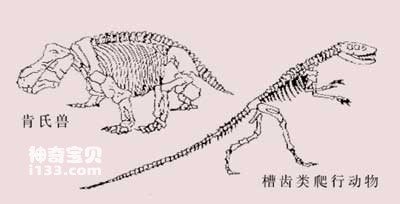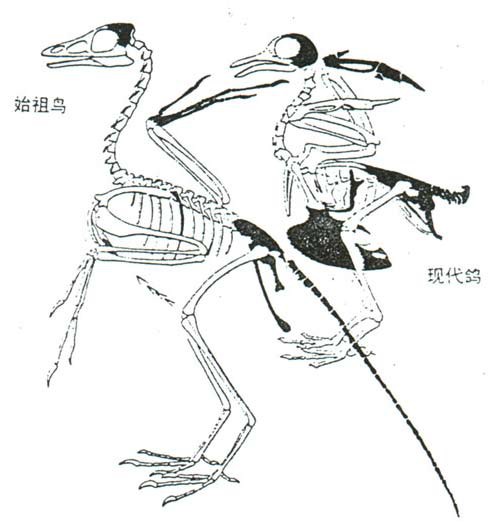The evolution of living things is not like modern humans climbing stairs, from the top of one staircase to another. It is a transition from the ancestral form of this group to another group. Birds evolved from an early branch of reptiles. The earliest bird fossil is the world-famous Archaeopteryx. Its body is as big as a crow, and it has reptile teeth, tail and tail vertebrae. It has bird-like forelimbs transformed into feathered wings, but the wings also have reptilian claws.

Alveolar reptiles and kemtheria
In the era when dinosaurs were kings, another group of small animals that evolved from the original reptiles, the Cynognathus, had already begun to move; they were carnivores with four legs, only as big as a mouse. It shares two major characteristics with Archaeopteryx: first, its whole body is covered with down or feathers; second, they are endothermic animals, and they always maintain a constant body temperature regardless of whether the external environment temperature is high or low.
When the external environment is still very warm, long hair and constant body temperature do not show any advantages, and their developed brains do not show any prestige. Because at that time, tree plants were still dominant, and flowering plants also appeared. You can find willows, maples, hawthorns... There was abundant food everywhere, and even the most clumsy and slow animals would not go hungry.

Comparison of the skeletons of Archaeopteryx and modern animals
This type of small animals are mammals! At that time, they were caught in the cracks of the prosperous dinosaur world, quietly living a hard life that was not easily discovered, and this lasted for 100 million years. Later, great changes took place in the earth's crust; volcanoes erupted, mountains rose, glaciers swept across, and seawater advanced and retreated. In addition to many reasons that are still unknown, the huge dinosaurs that were once arrogant and dominated for 160 million years almost disappeared. All become extinct. At present, some scientists believe that the impact of a "comet" on the earth changed the earth's environment. For a period of time, the sky was dark and the temperature dropped sharply. The food chain that maintained the survival of dinosaurs on the earth was destroyed, causing the dinosaurs to become extinct.
The earth has returned to warmth after the severe cold. The ginkgo, metasequoia, and cold-tolerant pines and cypresses that once witnessed the life of dinosaurs have all survived. As a new force, angiosperms began to develop, and for the first time the world saw a flourishing scene of flowers blooming.
There are only four remaining descendants of the once-popular dinosaurs: lizards, turtles, turtles and snakes.
Cold-blooded animals whose body temperature can only change according to the coldness and warmth of the external environment cannot withstand the invasion of cold and will either die or feign death - hibernation. Mammals and birds, the warm-blooded animals with hair and a constant body temperature, obviously realize their own superiority when looking at the remaining descendants of the giant beasts that once ruled the world - turtles and snakes. As a result, birds and mammals began to develop and spread...
The earliest mammals looked very strange. The platypus living in Australia has fur on its body like a cat, and its body temperature is not constant, varying between 26-35°C. It has mammary glands but no breasts, and feeds its young with milk; but it is an oviparous animal like a turtle. From the above characteristics, we can see that the platypus has both the characteristics of reptiles (egg laying, unstable body temperature, etc.) and the characteristics of mammals (fur, mammary glands, feeding young with milk, etc.), which shows that the platypus is the most primitive among mammals. group, and we can also see the genetic relationship between the ancestors of mammals and reptiles.
Another type of animal that still lives in Australia is the kangaroo. Although it does not lay eggs like the platypus, its babies only stay in the mother's belly for 7 weeks before they are born. They are not fully developed and are blind (eyes). (not opened), it will stay in the mother's pouch for another 6 months before being born.
By about 7 million years ago, mammals entered their peak period. The earth is almost as colorful as it is now: colorful, with birds singing and flowers fragrant, and a scene of singing orioles and dancing birds. Mammals occupy every corner of the earth: antelopes in the mountains, cattle and sheep in the grasslands, horses in the fields, bats in the air, moles in the ground, whales, sea veins and seals returning to the ocean, etc.
Who will be the ruler of the new world? In the forests of Africa and Asia, primates swinging from tree branches are the most promising. Their front legs and hind legs begin to divide their duties: the hind legs support the body, and the front legs are often used to try to do something, becoming more and more like arms. The hands and feet can grasp things, and they can hang themselves on trees. The fingers and toes are getting longer and longer, so that the thumb of the ancient ape can face the other four fingers, making it the most dexterous hand in the animal world. The arboreal life of ancient apes requires a pair of good eyes. Its two eyes can focus on one thing at the same time, which is something that mammals such as dogs and rabbits cannot do. It can bring food to its mouth with its hands, so its mouth is getting smaller and smaller, its brain is getting bigger and its intelligence is getting more developed. They have been evolving successfully. Three million years ago, very recently, the earth changed again, and ice and snow expanded from the northern and mountainous areas to the southern plains. Those creatures that were not resistant to the cold and had no time to retreat died.
Primates living in trees moved to the southern forests, and one of the ancient apes began to live on the ground from the trees. When the ice and snow struck from the north again, the ancient apes divided into two groups. One group continued to move to the southern forests and continued to live in the trees suitable for the forest environment, thus developing into today's gibbons, gorillas and chimpanzees. They are very similar to humans. Their blood type, bones, and even facial expressions and budding consciousness are similar to those of today's humans. Another group of ancient apes has adapted to life on land and can still make a living without forests. They finally survived the hard and cold years, went on and on, lived tenaciously from generation to generation, and finally evolved into the ape-man, the recent ancestor of human beings.
The Peking Man, located in Zhoukoudian, Beijing, lived 500,000 years ago. The earliest apes began to evolve towards humans by making simple tools. Labor enabled the ape-man to escape from the animal state and enter the human century.
Modern ancient people used their own labor and wisdom, and relied on the continuous innovation of tools to transform nature to better suit the needs of their own lives.
Now let’s review the entire long process of the origin and evolution of life. If the long geological time since the formation of the earth is "compressed" into 12 months a year, then:
The earth was formed in January, the crust condensed in February, the primitive ocean was created in March, the first life appeared in April, the earliest fossils were formed in May, dinosaurs dominated everything in mid-December, and the earliest primates were in December It appears at the end of the month, and the age of man only begins on the last day of the year. In fact, it was around 10 o'clock in the evening on December 31st that he truly transformed from an animal into a human being.
animal tags:
We created this article in conjunction with AI technology, then made sure it was fact-checked and edited by a Animals Top editor.